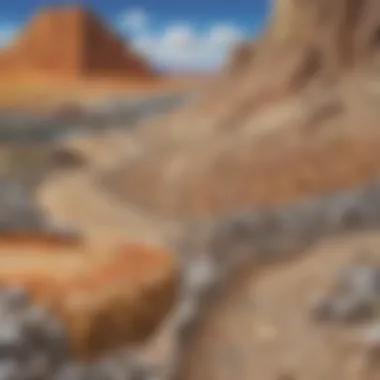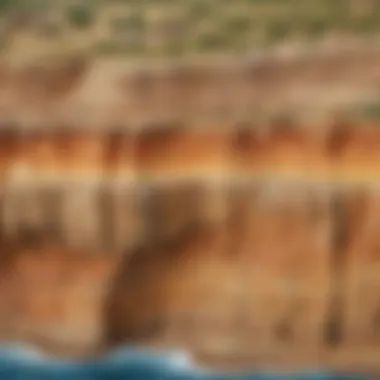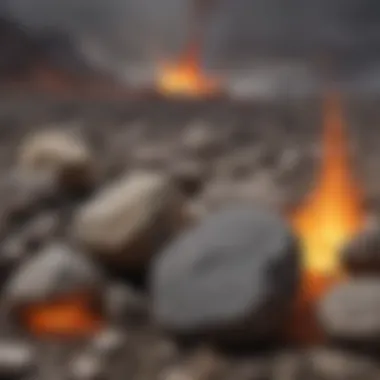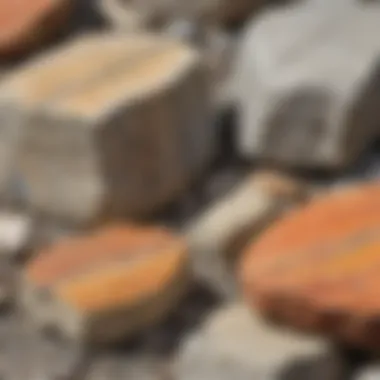Understanding the Rock Cycle: A Guide for Kids


Intro
The rock cycle represents a fascinating process through which rocks undergo various transformations over time. This cycle is crucial for understanding Earth’s geology. It involves the creation, breakdown, and reformation of different rock types. From the formation of igneous rocks from molten magma to sedimentary rocks formed by sediment compression, students can learn much about our planet's history.
Science Fun Facts
Interesting Trivia and Facts
- Did you know that there are three major types of rocks? They are igneous, sedimentary, and metamorphic.
- The Earth’s crust is made up of several layers, with rocks being one of the most vital components.
- Rocks can change form over millions of years. In fact, granite can transform into gneiss through heat and pressure!
Quirky Science Stories
In ancient times, people thought rocks contained spirits. They believed that certain rocks granted them strength and wisdom. Many cultures even built structures using stones, thinking they held magical powers.
Amazing Science Records
The largest diamond ever discovered is the Cullinan diamond, weighing an incredible 3,106 carats! It originated in South Africa and has a rich history connected to the British monarchy.
Thought-Provoking Questions
- How long do you think it takes for rocks to change from one type to another in the cycle?
- Why do some rocks last longer than others?
Discover the Wonders of Science
Exploring Various Scientific Concepts
The rock cycle encompasses essential concepts like erosion, sedimentation, and metamorphism. Understanding these key processes helps illustrate the dynamic nature of our planet.
Educational Videos and Animations
Visual aids enhance learning. Several educational platforms provide videos explaining the rock cycle. Sites like Britannica offer engaging content.
Interactive Learning Tools
Interactive games available on websites such as Reddit allow students to engage with geological sciences. Children can explore the rock cycle through simulations and activities.
Real-Life Applications of Science
Understanding the rock cycle helps in various fields, including environmental science, archaeology, and even education. Knowing how rocks influence ecosystems enhances our appreciation for nature.
Science Quiz Time
Interactive Quizzes
Quizzes can reinforce learning. Platforms like Facebook have educational groups where families can enjoy science quizzes together.
Multiple Choice Questions
- Which type of rock forms from cooling lava?
a) Sedimentary
b) Igneous
c) Metamorphic - What is the main process in forming sedimentary rocks?
a) Erosion
b) Melting
c) Cooling
Brain Teasers and Puzzles
Children can enjoy simple puzzles about rocks and their properties. This is a fun way to learn while engaging critical thinking skills.
Learning Through Gamification
Using games to learn about the rock cycle can keep students interested. Platforms that incorporate game-like scenarios into science lessons maximize engagement.
Science Experiment Showcase
Fun and Engaging Experiments
Students can explore the rock cycle by creating their recipe for sedimentary rocks using sand and clay.


Step-by-Step Instructions
- Gather materials: sand, clay, and small rocks.
- Mix the sand and clay in layers to mimic sedimentary formation.
- Place small weights on top to simulate pressure.
- Let it dry and observe.
Materials List
- Sand
- Clay
- Small rocks
- Weights (small books or stones)
Safety Tips and Precautions
Ensure students wear gloves while handling materials to avoid messes. Always have adult supervision during experiments.
"Rocks are not just simple stones; they are windows into the history of our Earth."
As we explore this important geological cycle, students will deepen their understanding of how the Earth works. This foundational knowledge sparks curiosity and encourages further exploration of Earth's wonders.
Preamble to the Rock Cycle
The rock cycle is a fundamental concept in earth sciences. It explains how rocks change and transform through various processes over time. Understanding this cycle is crucial for young learners as it connects many aspects of geology and environmental science. This section helps set the foundation for students to grasp how rocks are not just static materials, but active participants in Earth's dynamic system.
This cycle illustrates how igneous, sedimentary, and metamorphic rocks are interlinked. For instance, the formation of one type of rock can lead to the creation of another. This interconnectedness fosters a deeper comprehension of natural processes and their outcomes. It highlights how the earth's crust is constantly evolving and how this evolution affects our surroundings.
Furthermore, the rock cycle is relevant beyond academic boundaries; it helps students understand natural resources, environmental changes, and geological phenomena. By learning about the rock cycle, children become more aware of how human actions can influence the earth. This knowledge can inspire them to take positive steps towards environmental protection and sustainability.
"Rocks may seem unchanging, but they are constantly undergoing transformations that shape our world."
In summary, this section lays out the importance of understanding the rock cycle. It promotes an appreciation of Earth's processes and lends insight into larger environmental issues that affect all life forms.
Types of Rocks
Understanding the different types of rocks is crucial in learning about the rock cycle. Rocks are not just pieces of earth's crust. They tell us a lot about the planet's history, composition, and the processes that shape it. Each type of rock forms through distinct mechanisms, and each plays a unique role in the cycle itself. Recognizing these types helps students develop a deeper appreciation of geology and the natural world around them.
Igneous Rocks
Igneous rocks are the first type in the rock cycle. They form when molten rock, known as magma, cools and solidifies. This can happen beneath the Earth's surface or following a volcanic eruption. When magma cools slowly underground, it creates intrusive igneous rocks. These rocks often have larger crystals. On the other hand, when lava cools quickly on the surface, it produces extrusive igneous rocks, which generally have smaller crystals. Common examples of igneous rocks include granite and basalt.
Igneous rocks are the building blocks of the Earth's crust.
Sedimentary Rocks
Sedimentary rocks form from particles that settle and compact over time. These particles can be bits of other rocks, minerals, or even organic materials like plants and shells. Over time, layers of sediment accumulate and harden into rock through a process called lithification. This process can take thousands to millions of years. Sedimentary rocks often contain fossils, which can give us insight into past environments and life on Earth. Common examples include limestone and sandstone. Recognizing these rocks helps us understand how the Earth's surface has changed over time.
Metamorphic Rocks
Metamorphic rocks are formed through the transformation of existing rocks. This change occurs under high pressure and temperature but without the rock melting. The original rock, called the parent rock, may be igneous, sedimentary, or even another metamorphic rock. During metamorphism, minerals in the rock may rearrange or change chemically, leading to new textures and properties. For instance, limestone can turn into marble, while shale may become slate. Understanding metamorphic rocks is vital because they reveal the dynamic processes happening deep within the Earth.
Processes in the Rock Cycle
The rock cycle consists of a series of processes that illustrate how rocks change from one type to another over time. Understanding these processes is critical for grasping the dynamic nature of our planet. Each process has important roles, and recognizing these roles can help students appreciate the complexities of Earth’s geology. For example, by learning about how rocks form, break down, and reform, students start to understand the interconnectedness of natural systems. This knowledge can inspire curiosity and lead to deeper studies in earth sciences.
Formation of Igneous Rocks
Igneous rocks are formed from the cooling and solidification of magma or lava. This process can take place either beneath the Earth’s surface or on its surface during volcanic eruptions. When magma cools slowly underground, it forms large crystal structures, resulting in rocks like granite. Conversely, when lava erupts and cools quickly on the surface, it may form rocks like basalt. Understanding igneous rock formation helps students learn about geological activity beneath the Earth and the effects of volcanic activity.
Key Fact: Igneous rocks are classified into two main types: intrusive and extrusive, depending on where they solidify.
Weathering and Erosion
Weathering and erosion are processes that break down rocks into smaller particles. Weathering involves the chemical, physical, and biological breakdown of rocks. For instance, water can seep into cracks in rocks, freeze, and expand, causing the rocks to fracture. This is called freeze-thaw weathering. Erosion, on the other hand, is the movement of these particles from one location to another, often driven by water, wind, or ice. These processes are vital in shaping landscapes and forming sedimentary rocks, making them significant in the study of earth sciences.
- Weathering Types:
- Erosion Agents:
- Physical weathering
- Chemical weathering
- Biological weathering
- Water
- Wind
- Ice


Lithification of Sedimentary Rocks
Lithification is the process of transforming sediment into solid rock. This happens through compaction and cementation. Over time, layers of sediment accumulate, and the weight of the layers above compresses those below. This leads to lithification, forming rocks like sandstone or limestone. It is an essential process in the rock cycle, as it explains how our planet stores carbon and creates essential resources like fossil fuels. Knowing about lithification allows students to appreciate the slow processes that create rocks we see today.
Metamorphism and the Creation of Metamorphic Rocks
Metamorphism occurs when existing rocks are subjected to increased temperature and pressure, leading to significant changes in their structure and mineral content. For example, shale can transform into slate under these conditions. This process can happen deep within the Earth where heat and pressure are intense. Understanding metamorphism reveals how rocks can change over geological time, contributing to the rock cycle’s ongoing cycle of transformation. This insight invites young learners to think about how Earth is constantly changing and reshaping itself.
The Rock Cycle Diagram
Understanding the rock cycle is crucial for young learners in grasping how earth works. A well-illustrated diagram serves as a bridge between complex processes and clear visual comprehension. This section presents the rock cycle diagram, crystallizing key concepts into digestible information for elementary students.
Understanding the Diagram
A rock cycle diagram visually represents the processes shaping rocks over time. It demonstrates how igneous, sedimentary, and metamorphic rocks change due to various natural forces. With color-coded sections, the diagram highlights the individual rock types and their transitions.
The diagram is important because it organizes information systematically. It allows students to see connections between processes like weathering, erosion, and lithification. With simple labels and arrows, students can follow the journey of rocks, from one form to another.
In essence, it breaks down the rock cycle into manageable parts, making complex ideas accessible. Learning becomes more effective when students can relate textual information to a visual format.
Key Elements of the Rock Cycle
Students should focus on several key elements in the rock cycle diagram:
- Igneous Rocks: Formed from cooled magma or lava, visible at the top of the cycle.
- Sedimentary Rocks: Created from compaction and cementation of sediments, often illustrated on the lower side of the diagram.
- Metamorphic Rocks: Indicate rocks transformed by heat and pressure, usually shown on the side of the cycle.
- Processes: Highlighted arrows connect these elements and represent processes like melting, cooling, and eroding.
These elements help elucidate the rock cycle's dynamic nature. Using the diagram in education enhances understanding. It enables students to appreciate the cyclical movement and transformation of materials within the Earth's crust.
"Understanding the rock cycle is key to unlocking the mysteries of our planet’s surface."
Recognizing these components encourages curiosity about geology. Students might wonder how rocks form around them, leading them to seek further knowledge. The rock cycle diagram serves as both an educational tool and a starting point for their exploration of this vast subject.
Real-world Examples of the Rock Cycle
Understanding real-world examples of the rock cycle helps students connect geological concepts to their everyday life. This section illustrates how the processes we studied occur in nature, shaping the world around us. Through practical examples, students can appreciate the active role of rocks, from mountains to volcanoes and beyond.
Formation of New Mountains
Mountains offer one of the most observable instances of the rock cycle in action. The formation of new mountains primarily occurs through tectonic forces. These are very large and powerful forces generated by the movement of tectonic plates beneath the Earth's surface.
- Plate Tectonics: When two tectonic plates push against each other, they can cause the land to buckle and raise. This process is known as orogeny. It leads to the creation of mountain ranges. For example, the Himalayas were formed as the Indian Plate collided with the Eurasian Plate.
- Erosion and Weathering: Once mountains form, they do not stay unchanged. Erosion, driven by wind, water, and ice, gradually wears down these elevated landforms. This process causes rocks to break apart, forming sediment. The sediment can then become part of new sedimentary rock layers over time.
- Example: The Rocky Mountains in North America are a prime example of this cycle. They were once underwater, uplifted through tectonic activities, and have undergone weathering and erosion that shape their present landscape.
By studying mountains, students can understand the dynamic nature of the Earth's surface and the ongoing processes that shape it. Mountains are not just beautiful, but they also tell stories of Earth's history.
The Role of Volcanic Eruptions
Volcanic eruptions play a significant role in the rock cycle, contributing to both the formation of new igneous rocks and the alteration of existing landscapes. These eruptions occur when magma from beneath the Earth's crust breaks through to the surface. This process has several key aspects:
- Formation of Igneous Rocks: When a volcano erupts, it spews out lava, ash, and other materials. As the lava cools and solidifies, it forms igneous rock. This is a direct demonstration of the cycling through lava processes where rock materials are recycled back into solid forms.
- Land Creation: Volcanic eruptions can create new landforms. For instance, the Hawaiian Islands were formed from multiple volcanic eruptions that built up the land over time. Each time a volcano erupts, new material is added, which can eventually lead to new islands or landforms.
- Ecosystem Changes: Volcanic activity also alters local ecosystems. The ash from eruptions can enrich the soil, allowing for new vegetation growth. This highlights the interconnectedness between geology and biology. The islands formed can become homes for unique species, showing how geological changes can impact ecological systems.
"Volcanic eruptions are more than just destructive forces; they also drive creation and transformation in the world around us."
In summary, volcanic eruptions exemplify the rock cycle's dynamic nature, serving as powerful reminders that change is constant. Both mountains and volcanoes illustrate how the Earth actively reshapes itself, giving students concrete examples of complex geological processes. Learning about these examples can inspire awe and curiosity about the Earth and its history.
Importance of the Rock Cycle in Nature
The rock cycle plays a vital role in shaping the Earth's landscape and supporting diverse ecosystems. It involves continuous processes that transform rocks from one form to another. This cycle is not just a geological process but also an essential part of environmental health. Understanding its importance can help young learners appreciate how the Earth works and how rock interactions affect their surroundings.
One major aspect of the rock cycle is its influence on ecosystems. As rocks break down through weathering, they create soil, which is crucial for plant growth. Healthy soil supports vegetation, which in turn supports various animal species. Therefore, the connection between rocks, soil, and living organisms is direct and significant.
Moreover, the rock cycle contributes to the overall balance of the Earth’s materials. Elements like carbon and nutrients cycle through rocks, air, water, and living things. This cycling is essential for processes like photosynthesis and respiration, which are critical for life. The rock cycle also helps in regulating climate by controlling carbon dioxide levels in the atmosphere through processes such as weathering.
"The rock cycle is a fundamental aspect of Earth’s systems, linking land, air, water, and life."


Ecosystem Implications
Ecosystems depend on the continuous cycling of rocks and minerals. When rocks break down into sediment, they form the foundation for new habitats. Plants, insects, and animals rely on soil created from rocks. Nutrient-rich soils enable plants to thrive, which then supports higher trophic levels in the food chain.
Additionally, specific rocks can influence local environments. For example, limestone can neutralize acidity in soils and water, creating a healthier environment for various organisms. In contrast, volcanic rocks can enrich the soil with minerals, making it more fertile. Understanding these interactions reveals how rocks support life in various ecosystems.
Human Impact and Resource Use
Humans have a profound impact on the rock cycle. Activities like mining and construction directly alter the landscape. When we extract minerals from the Earth, we affect the natural processes of the rock cycle. Over time, excessive resource use can lead to problems like erosion and habitat loss.
However, while these activities can disrupt the cycle, they also illustrate its importance. Minerals and resources derived from the rock cycle are essential for our daily lives. From building materials to electronics, the products we use often come from rocks. Understanding the rock cycle can lead to more responsible resource management. It encourages sustainable practices that recognize the need to balance human resource extraction with the needs of natural ecosystems.
Experiments for Young Learners
Experiments are a valuable way to deepen understanding of the rock cycle. They allow students to see geological concepts in action. Hands-on activities engage young minds and help solidify complex ideas. Learning about geological processes through experimentation can also spark curiosity about the natural world. Such activities can promote critical thinking and problem-solving skills as students observe and analyze their results.
Benefits of Experiments for Students:
- Enhances understanding of rock formation and transformation
- Encourages curiosity and exploration
- Provides a practical approach to learning complex concepts
- Develops observational and analytical skills
Considerations include ensuring safety during experiments, especially when using materials like vinegar for simulating volcanic eruptions. Supervision may be necessary for younger children. It's important to follow instructions carefully for accurate results. Students should also reflect on what they learned from each experiment. By examining their findings, they can make connections to the rock cycle.
Review and Key Takeaways
Understanding the rock cycle is essential for grasping how our planet functions. This section aims to summarize the main ideas discussed in the article and reinforce their significance.
Summarizing Key Concepts
The rock cycle is a continuous process that describes how rocks change from one type to another over geological time. In this cycle, we learned about the three main types of rocks: igneous, sedimentary, and metamorphic. Each type has its own formation process and characteristics. We also explored the processes that drive these transformations, such as weathering, erosion, and volcanic activities.
The importance of the rock cycle extends beyond just the rocks themselves; it plays a crucial role in shaping the Earth's surface and supporting ecosystems. For instance, the creation of soil from weathered rocks supports plant life, which in turn sustains animal life. Recognizing these connections helps us appreciate the balance of nature and the resources we depend on.
Encouraging Further Exploration
Encouraging curiosity is vital for young learners. Exploring the rock cycle opens doors to a deeper understanding of geology and earth sciences. Parents and educators can stimulate interest by providing additional resources, such as:
- Books for Young Readers: There are many books available that discuss rocks, minerals, and the geology of the Earth in a fun and engaging way.
- Online Resources and Websites: Websites like Wikipedia and Britannica offer reliable information about rocks and geology. Engaging with interactive games or quizzes can also solidify knowledge.
Joining local rock hounding clubs or visiting natural history museums can further enrich this learning experience. These activities encourage hands-on experiences and allow children to connect with nature directly.
"Understanding the rock cycle is the first step toward appreciating our planet's dynamic nature and history."
Resources for Further Learning
Diving deeper into the rock cycle might seem overwhelming at first. However, resources for further learning play a critical role in making this complex subject more accessible. These resources range from books to online materials, offering a variety of formats and learning styles. They not only enhance understanding but also spark curiosity and engagement in students. By providing options for expanding knowledge beyond the classroom, these materials support a child’s overall education in earth sciences.
Using diverse resources helps to solidify concepts by presenting information in different ways. For instance, visual aids like diagrams and videos can simplify tricky topics. Additionally, interactive websites offer engaging activities that turn learning into a fun experience.
In this section, we will explore two main types of resources: books designed for young readers and online resources, including educational websites. Each of these types plays an unique role in facilitating a deeper understanding of the rock cycle.
Books for Young Readers
Books serve as excellent tools to introduce young learners to the rock cycle. Finding the right book can stimulate interest and develop a solid foundation in geology. These books often illustrate concepts with vivid pictures and simple language, making complex ideas easier to understand.
Some highly recommended titles include:
- "Rocks and Soil" by Jennifer Ward: This book is a great introduction to different kinds of rocks, including their properties and formations.
- "The Magic School Bus Inside the Earth" by Joanna Cole: This title combines fun storytelling with educational content about geology.
- "How Mountains Are Made" by Rebecca L. Johnson: This book covers how mountains form, with a focus on the processes in the rock cycle.
Reading these books can engage the imagination. They not only contain factual information but also present it in a narrative form. This encourages children to discover more about the world around them.
Online Resources and Websites
In today's digital age, online resources greatly complement traditional learning. Many websites are dedicated to teaching kids about earth sciences and the rock cycle. These platforms often feature interactive activities, quizzes, and visuals that can make learning exciting and interactive.
Some valuable online resources include:
- National Geographic Kids (kids.nationalgeographic.com): This site provides articles, images, and videos related to geology and rocks.
- PBS Learning Media (pbslearningmedia.org): Offers educational videos and lesson plans about earth sciences for educators and students.
- Kids Discover (kidsdiscover.com): Features engaging articles and worksheets specifically designed for young learners.
By integrating these online resources with classroom instruction, students can experience a more holistic learning approach. The hands-on activities available can reinforce concepts learned in more traditional settings.
The combination of books and online resources will help develop a comprehensive understanding of the rock cycle. This understanding will inspire students to explore further and ask questions about nature and the environment.







